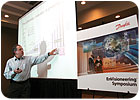
Some 25 experts from the HVAC&R industry addressed growing concerns about the U.S. energy situation at the Danfoss EnVisioneeringSM Symposium, held in June. Called “Making Dollars and Sense of Energy Efficiency: A Focus on Conservation,” the symposium was the fifth in the EnVisioneering series.
“Without question, there is a growing need for a solid assessment of the economic payback of energy efficiency,” said John Galyen, host of the symposium and president, Danfoss Refrigeration & Air-Conditioning, North America. “One of the key questions the HVAC&R industry needs to ask is: Can total life-cycle costing help to significantly change buying practices in energy-efficiency solutions?”
Mark Bernstein, visiting professor, Future Fuels and Energy Initiative, Department of Political Science, University of Southern California, suggested “It’s going to take a sustained period of high energy prices and reliability problems to really change people’s attitudes and behaviors about energy use and efficiency.”
Henry Lau, 2006-08 Emerging Technology program manager, Southern California Edison, noted California is saving millions of dollars through energy-efficiency programs. “The objectives of our program are to 1) provide new technologies to the energy-efficiency programs so they can achieve their energy savings goal, and 2) create a balancing portfolio for the various market segments. We select new technologies based on the following criteria: large energy savings, great demand reduction, large market potential and minimum market barriers.”
Kent Peterson, president-elect, ASHRAE, and vice president, principal and chief engineer, P2S Engineering, Long Beach, cited a recent U.S. Energy Information Administration report projecting a 71% increase in worldwide energy consumption between 2003 and 2030. Currently, buildings account for 40% of U.S. energy consumption, followed by industrial, 32%, and transportation, 28%.